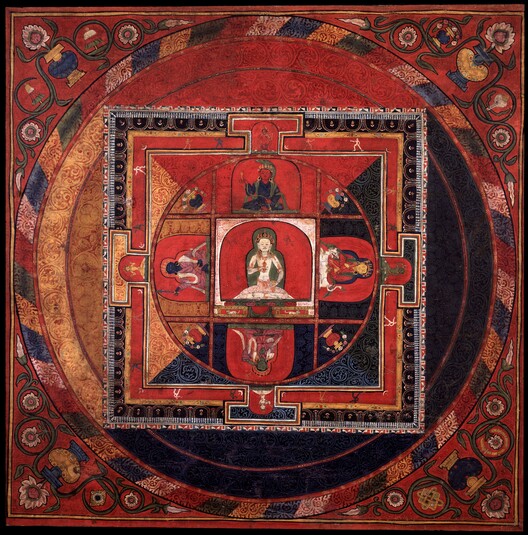
Item: Mandala of Vajrapani (Bodhisattva & Buddhist Deity) - (Sarvadurgati Tantra, Four Kings)
| Origin Location | Central Tibet |
|---|---|
| Date Range | 1400 - 1499 |
| Lineages | Sakya and Ngor (Sakya) |
| Size | 40.64x40.64cm (16x16in) |
| Material | Ground Mineral Pigment on Cotton |
| Collection | The Brooklyn Museum of Art |
| Catalogue # | acc. #BMA 81.10. Gift of E.C.Woodward & various funds |
| Painting School | Ngor |
Classification: Deity
Appearance: Peaceful
Gender: Male
Vajrapani and the mandala of the Four Great Kings of the Directions from the Parishodhana Tantra.
Within the center of the two dimensional circular diagram (mandala) representing the top view of a three dimensional celestial palace and surroundings is Vajrapani, white in colour, with one face and two hands, holding in the right a vajra to the heart and with the left a bell at the left hip; adorned with jewelled ornaments and garments of silk, with a green aureole and nimbus behind.
In the surrounding four main and intermediate directions on a large eight sectioned dias are the 4 Great Kings of the Directions each with one face and two hands holding their own unique symbols; wearing flowing garments, adorned with jewel and gold ornaments. Four initiation vases are placed in the intermediate directions.
The floor of the palace is divided into four colours; red, green, yellow and blue. The outer square enclosure composed of variously coloured lines are the four palace walls, with a red veranda outside, adorned with 16 offering goddesses of various colours. Each of the four doors (?T? shaped) has a guardian. The outermost stylized square represents the ornate roof. The palace rests on a circle of decorative lotus patterns surrounded by the ring of five coloured flames of pristine awareness. Each corner is adorned with a vase and lotus motif enriched with green vines, white circular blossoms and auspicious emblems.
The mandala of Vajrapani and the 4 Guardian Kings belongs to the set of 12 mandalas arising from the Sarvadurgati Parishodhana Tantra (Eliminating all Bad Rebirths) of the Yoga classification of the Sarma Schools.
The painting is executed in Nepali style popular in the early period of Ngor monastary evidenced by the strong red and blue colours, copious floral patterning and rigid adherence to geometric form.
(See the painting Vajrapani and the 8 Great Nagas from the same set).
Jeff Watt 3-2002
Mandala: Mandala Main Page
Tradition: Sakya Deity Paintings
Buddhist Deity: Vajrapani Main Page
Painting Style: Tibet (Balri)
Mandalas: Sakya Tradition
Collection of Brooklyn Museum of Art
Buddhist Deity: Sarvavid, Parishodhana Tantra Mandala List
Painting Style: Ngor Mandalas
Collection of Brooklyn Museum of Art (Deities)
Buddhist Deity: Vajrapani & Four Kings (Sarvadurgati)
Buddhist Deity: Vajrapani (Peaceful Iconic Figures)
Buddhist Deity: Vajrapani Mandalas
Buddhist Deity: Vajrapani, Peaceful, Main Page
Buddhist Deity: Vajrapani (peaceful, vajra & bell)
Buddhist Deity: Sarvadurgati Tantra Mandalas (Masterworks)
Painting Set: Sarvadurgati Parishodhana (Ngor)
Buddhist Deity: Vajrapani Iconography
Collection of Brooklyn Museum of Art (Masterworks)
Subject: Confusions (Vajrasattva & Vajrapani)
Buddhist Deity: Sarvavid (Vajrapani Mandalas)
Buddhist Deity: Vajrapani Masterworks (Paintings, Peaceful)
Collection of Brooklyn Museum of Art (Painting Masterworks)

